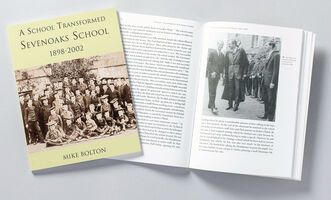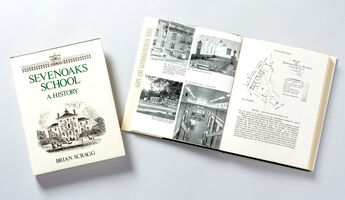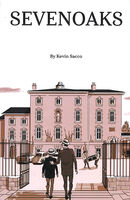The School Archive
Delve into Sevenoaks School's history with the fascinating articles below researched and written by school archivist Sally Robbins.
Several histories of the school by former staff and OS are available to buy:
A School Transformed: Sevenoaks School 1898–2002 by Mike Bolton, former Undermaster
Sevenoaks School: A History by Brian Scragg, former Undermaster
History of Music at Sevenoaks School 1877-2010 by Peter Young, former Head of Music
Sevenoaks written and illustrated by Kevin Sacco (OS 1970)



Email the archivist for queries relating to Sevenoaks School's history, to purchase books or to donate an item to the archive.
Sevenoaks School and the Aisher Legacy

This month sees the opening of the school’s newest boarding house – Aisher House - sited on the Park Grange estate, designed to house 60 middle and upper school boys. The name reflects, as many OS will be aware, the important and historic connection of the Aisher family with Sevenoaks School.
That association began in 1963 when the Governors launched an Appeal to raise the money needed to fund their five year building projects plan and in particular for a Social Activity Centre, classrooms and Dining Hall complex. It was an ambitious aspiration for a Board which “lacked any member in the high echelons of administration and finance…. [and] moreover…had little representation from large business in Sevenoaks” as its Chairman, Lord Sackville recalled. He therefore took the initiative to approach the firm that was one of the biggest employers in the Sevenoaks area and whose managing family were known to be local philanthropists – the Marley Tile Company and the Aisher family.
Owen and Jack Aisher’s fortune stemmed from their father (also) Owen’s discovery in the 1920s of a way of making concrete roof tiles, in large enough quantities, and then supplying them to the building trade. Expansion both in terms of factory sites (they made Riverhead, Sevenoaks their Headquarters in 1935) and range of products manufactured continued apace following the creation of the Company in 1926 and by the mid-1960s both brothers were joint Chairmen of the Company and Owen was on track to become the highest paid company boss in the country by the end of the decade.
With little formal schooling themselves, they appreciated the value of a good education especially to those pupils who came from modest backgrounds. It was Jack Aisher who joined the Sevenoaks Board of Governors in 1964, but Owen Aisher (junior) also and the firm as a whole played their part too in supporting the school “both financial and administrative…on a scale unknown since the days of Charles Plumtre Johnson” over the next twenty five years [Sevenoaks School A History, B. Scragg].
The Appeal had failed to make much progress by the time Jack Aisher joined the Board apart from the creation of a large hole in the ground near the present day Flat area and the laying of a commemorative foundation stone. Aisher not only took charge of the Appeal’s management, he (on behalf of his company) also offered to match any sum raised; £182,000 was the final total and the new buildings opened in 1967.
1967 also saw the opening of another Aisher family benefaction – the Aisher Hall Music Centre - the personal gift of Eileen Aisher, Jack’s wife. As well as practice rooms the new building also included two orchestra rooms, auditorium, staffroom and storeroom. The Hall’s legacy in raising the standard of Music at the school is unquestionable and its idiosyncratic shape became a distinctive feature of the school’s campus. “A nut surrounded by the jaws of a wrench” [Sennockian 1967]; “a giant orange juicer” [Joe Stilgoe, Sennockian 2009]; “a spaceship just landed” [Emma Johnson, Ibid] were just some of the attempts to describe it.
Its activities eventually outgrew the space and in 1990 more Aisher funding provided for an extension of an additional ten teaching rooms and an ensemble room. It was superseded by the new Performing Arts Centre in 2010 but maintained a role in the school as the Higher Education and Study Centre.
Late in 1972 Alan Tammadge was “thunderstruck” [B. Scragg, Ibid] when Jack Aisher presented him with a proposal to build a new Sports Centre for the school as a commemoration of Marley’s fiftieth anniversary in Sevenoaks. It was designed by OS Claude Kempton to complement the view across to Knole and use Marley manufactured materials. Unfortunately none of the original plans (swimming pool, offices, equipment store, circuit training range, squash courts, changing rooms and snack bar) came to fruition - the project fell victim to the uncertain political and financial climate of the time and took over four years to construct.
The building that opened in April 1977 was considerably smaller than originally proposed (only the sports hall, gymnasium and a few offices remained) but it was an event performed by the Prince of Wales: “the school authorities can be forgiven the odd polite smirk since the snaffling of HRH to open the Sports Hall was a stroke of politic genius” [Sennockian 1977].
As with the Aisher Hall in its field, the contribution of the Marley Sports Centre to the development of Sport in the school was immeasurable. Again, as with the Aisher Hall, the Marley Sports Hall’s original purpose was eventually supplanted - by the opening of the Sennocke Centre in 2005, but it remained an intrinsic part of the campus both as a sports facility and also as the main examination centre in the school.
Less munificent ways of the support the Aisher family gave the school included such practicalities as offering sponsorship for those pupils wanting to do computing, business studies or engineering at university; by helping cover the production costs of the Sennockian by annually placing an advert in it; and by allowing the school’s first computer programmer to be “married up to the big computer at Marley Tiles” because “it is impossible in a school to keep a computer properly occupied” [Sennockian 1966].
Lord Sackville also gave recognition to the indiscernible but no less important encouragement given ‘behind the scenes’. Jack Aisher’s joining of the Board in 1964 “has proved to rank as one of the major high points of the school over the last thirty years…. the indefatigable application and skill which Jack showed as a Governor…always available…[giving] his advice when asked but…never offended if his advice was not taken…[although] such was usually a mistake” the Governors’ Chairman wrote in 1989 [Annual Review 1988/89].
In 1985 Jack Aisher retired as Chairman of the Marley Tile Company and in 1986 he also resigned as a Governor of Sevenoaks School. Although he and his wife moved away from the area to the South Coast he maintained contact with the school. Eileen died in 1992 and Jack in 2008; in 2016 the Aisher and Marley Halls were demolished as part of the completion of the landscaping of the Flat and building of the Global Study Centre and Science and Technology Centre.
